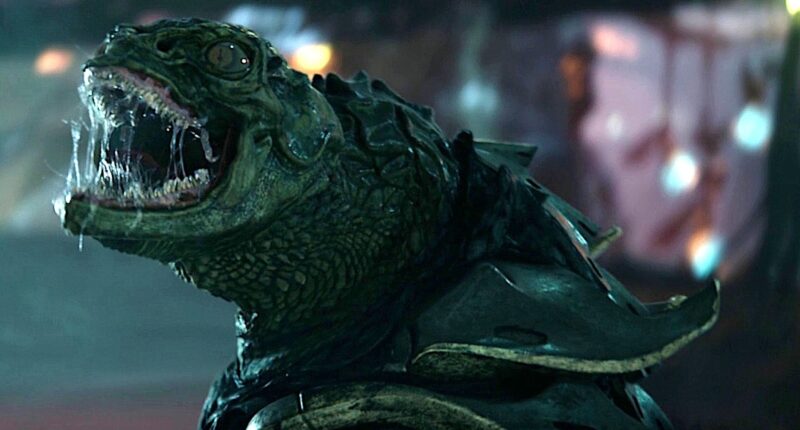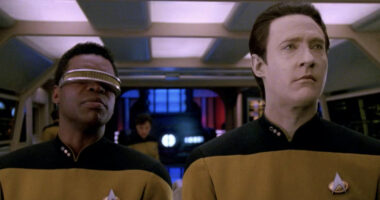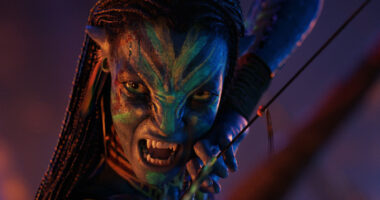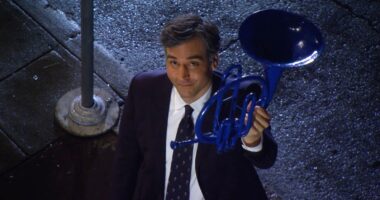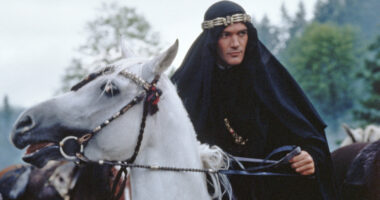Share this @internewscast.com
“Star Trek” stands as one of the most iconic and celebrated science fiction series ever. Whether you love it or not, the Enterprise, the holodeck, and the Vulcan nerve pinch are universally recognized. Its extraterrestrial species, like the Klingons, Vulcans, and the Borg, have embedded themselves in popular culture. However, one significant alien race, the reptilian Gorn, hasn’t achieved as much renown.
The Gorn appeared only once in the original “Star Trek” episode titled “Arena.” This initial portrayal featured a stuntman in a rudimentary foam and rubber costume, which might explain their lackluster fame compared to the Klingons. Among “Star Trek” fans, though, the Gorn are infamous, and “Arena” remains one of the cherished episodes. Filmed at the picturesque Vazquez Rocks in California, Captain Kirk’s climb up the rocky pinnacle became a memorable image, even being parodied in the 1991 movie “Bill & Ted’s Bogus Journey.”
Despite their reverence among sci-fi enthusiasts, the Gorn were shrouded in mystery until recently. Beyond their debut, they made a brief cameo in a forgettable episode of “Star Trek: The Animated Series” and appeared in an esteemed episode of “Enterprise.” However, it wasn’t until “Star Trek: Strange New Worlds” in 2022 that they were thoroughly explored. For those intrigued by these mysterious reptilians, we’ve prepared a helpful guide.
A star is Gorn
Although the rubber-suited Gorn in “Arena” seemed cheesy, the episode is among the finest of “Star Trek: The Original Series.” The narrative sees the Gorn attacking a Federation outpost in what seems like an unprovoked massacre, prompting the Enterprise to pursue them. The Metrons, a more advanced alien species, intervene, teaching both sides a lesson by making Captain Kirk and the Gorn captain face off in a duel on a desolate planet. In the climax, we discover the actual reason: the Gorn believed the Federation had encroached on their territory, establishing colonies unlawfully.
“Arena” ultimately emphasizes understanding other cultures before engaging in conflict. This theme, while not new to sci-fi, closely mirrors a tale published in a 1944 edition of “Astounding Science Fiction.” Sci-fi writer Frederic Brown authored this story, also named “Arena,” and “Star Trek” script editor Joan Pearce recognized the resemblance too late, leading to the studio crediting Brown to prevent legal troubles.
Additionally, a 1964 “Outer Limits” episode titled “Fun and Games” narrates an unusually similar storyline. Despite its origins, “Arena” is undeniably pivotal in the original “Trek” series, serving as a timeless episode with an impactful societal message.
The Gorn are reborn in Star Trek: Strange New Worlds
After “Arena,” it took more than 35 years before “Star Trek” fans got another live-action glimpse at the Gorn when one of the reptilian monstrosities showed up in a 2005 episode of the prequel series, “Star Trek: Enterprise.” This time, rather than foam, rubber, and latex, the Gorn were presented via CGI, which was helped by the fact that its appearance was kept mostly in shadow. It was nearly 20 more years before we saw them again, when “Star Trek: Strange New Worlds” used CGI once more to revitalize the Gorn for the Season 1 story “All Those Who Wander,” one of the most horrifying episodes in “Star Trek” history.
Far from the bipedal, mostly-humanoid lizards they were depicted as in “Arena,” the Gorn have been reenvisioned as a bloodthirsty race of monstrous aliens who apparently live to hunt, kill, and breed. They seem — at least at first — to be little more than mindless animals who operate on instinct alone. Similar to the Xenomorphs from the “Alien” franchise, the Gorn are shown laying eggs within the corpses of their victims. “Strange New Worlds” treats them as a Borg-like threat to the very ideals of the Federation, forcing us to ask if there are simply some adversaries that we will never truly understand.
The truth about the Gorn is still being revealed
In Season 1 of “Star Trek: Strange New Worlds,” we’re introduced to the Federation’s history with the Gorn through La’An Noonien-Singh (Christina Chong), the USS Enterprise’s security officer, who has a personal history with them. It’s revealed that when she was young, the Gorn attacked La’an’s home colony, using its people for food and their bodies as breeding pods. We learn that they even hold entire worlds as planetary nurseries where they collect these host bodies.
Gorn hatchlings, in a “survival of the fittest” manner, emerge from their eggs in groups and hunt each other until only the strongest remains. In addition to strength and speed, they possess powerful venom that can be hurled at prey. In the “SNW” Season 3 opener, “Hegemony, Part II,” the crew of the Enterprise discovers that the Gorn space fleet is preparing for an all-out invasion of the Federation … but it’s not for the purposes of hostile takeover. It’s discovered that the Gorn’s behavior is guided by stellar activity, with the radiation bursts from their home system’s binary stars triggering reproductive cycles and periods of increased aggression and hostility, as well as lengthy periods of dormancy.
Even more mysteriously, recent episodes of “Strange New Worlds” also revealed that a Gorn attack may involve a form of psychic damage left in their victims. Captain Batel — who had been infected with Gorn eggs — is seen suffering from nightmarish visions that appear to be much more than just bad, post-traumatic nightmares. Even worse, as of this writing, Batel appears to be transforming into a human/Gorn hybrid.
How the Gorn are causing canon issues for fans
Since the Gorn’s arrival in “Star Trek: Strange New Worlds,” some fans have expressed frustrations over the apparent retconning of “Trek” canon. In their first appearance, the Gorn are an intelligent, if crude, civilization fighting to protect their territory, far from the animalistic aliens they’re currently depicted as. The climax of the episode even has Kirk learning that his first impression of them as a monstrous race of beasts was all wrong.
By contrast, in “Strange New Worlds,” they appear to be near-mindless creatures hiding in the shadows, often driven by instinct alone, just as Kirk (incorrectly) believed. The minds behind “Strange New Worlds” have addressed these inconsistencies, explaining that they’re taking creative license with the events of “Arena” for the sake of creating new, dramatic stories. “What I loved about the Gorn was it was an opportunity to retcon something into a real monster,” producer Akiva Goldsman said at a panel at the Tribeca Film Festival (per TrekMovie). “We start by seeing the ‘other’ and often we end by engaging our empathy and understanding common ground. … And so what we wanted to do with the Gorn was to give you a monster, and a monster that at least at first, seemed irredeemable.”
Goldsman’s comments suggest that more revelations about the Gorn are coming. Perhaps we’ll learn, like in “Arena,” that the actions that initially seem monstrous — to the Enterprise crew and the audience — are likewise misunderstood. It’s also possible that the events of “Strange New Worlds” are precisely why Kirk believed them to be bloodthirsty animals in the first place. The big question that remains, however, is why Kirk and Spock didn’t seem to recognize the Gorn in “Arena” if they had so much experience with them in “Strange New Worlds.”
Why the Gorn went unexplored for 50 years
For more than 30 years, Trekkies had no idea what happened to the Gorn after the 23rd-century events of “Arena.” They were the rare alien adversary to barely receive as much as a mention in the ensuing 24th-century spinoffs “The Next Generation,” “Deep Space Nine,” and “Voyager.” The reason they were a no-show for so long likely had something to do with their visual depiction in the original “Star Trek” series, as the franchise evolved away from campier ’60s elements like the Gorn’s foam and rubber costume. Thankfully, CGI allowed producers to reimagine them for 21st-century “Trek,” but “Strange New Worlds” — which is always brimming with Easter eggs — also recently offered a potential in-universe reason for why we never heard from them in the ’90s shows.
In “Hegemony, Part II,” we learn that coronal mass ejections from the binary star system of the Gorn’s homeworld can alter their life cycles. At the end of the episode, Captain Pike and the Enterprise crew are even able to simulate the effects of such stellar activity, successfully tricking the Gorn into thinking it’s time to hibernate. While they caution that the star’s activity suggests a prolonged period of aggression on the horizon, the Gorn effectively go to sleep — at least for the time being.
Ultimately, we’re left with the distinct impression that the Gorn’s absence during the “Next Generation” era is due to them being in a period of hibernation, whether it’s the one triggered in “SNW” or another at a future point in time, possibly following “Arena.” This also suggests that future “Trek” shows may have to deal with the Gorn re-awakening once more…
The Gorn fail safe pays homage to the Borg
Producer Akiva Goldsman said that his plan for the Gorn on “Strange New Worlds” was to create an enemy that was a true monster that couldn’t be defeated by either diplomacy or conventional military might. This makes them the show’s equivalent to the Borg — a race of insidious alien creatures who are so different from humanity that it’s hard for us to even understand what drives them, let alone come to an understanding with them. So it may not be much of a coincidence that the solution to the dilemma in “Hegemony, Part II” is strikingly similar to the way Captain Picard and the Enterprise-D defeated the Borg in “The Best of Both Worlds,” which also happened to be a two-part, season-ending cliffhanger story.
In that 1990 episode, the Borg are on the verge of assimilating Earth into their collective. At the last moment, Commander Data is able to use the cybernetic interface in Captain Picard — who’d been partially assimilated into the Borg Collective — to issue an erroneous command into the Borg’s collective consciousness, telling them that it was time for their sleep cycle. In a near-identical climax in “Hegemony, Part II,” Pike does the same, tricking the Gorn into thinking it’s time to hibernate.
During the same panel at the Tribeca Film Festival, Akiva Goldsman noted that “Best of Both Worlds” was a big influence on “Hegemony,” which ended Season 2 on a brutal cliffhanger. Given that influence, it’s easy to see how the hibernation solution was very likely an intentional homage to “TNG’s” classic two-parter.
